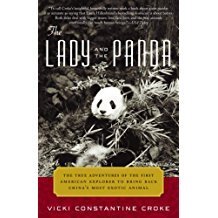
The Lady and the Panda: The True Adventures of the First American Explorer to Bring Back China’s Most Exotic Animal
By Vicki Constantine Croke. Random House, 2009, 402 pp.
In the 1930s, the adventurers who sought to capture wild animals—either dead, for natural history museums, or alive, for zoos—were mainly young men from wealthy, upper-class families. Ruth Harkness did not fit into this group: she was a party-loving New York dress designer with no trekking experience, she wasn’t rich, and, most exceptionally, she was a woman. But she was determined to go to the Chinese-Tibetan border to complete her late husband’s unfulfilled mission: to bring a living giant panda back to the United States. And against very long odds, she succeeded.
Although once celebrated—and still respected by naturalists and zoologists—Harkness was a little-known figure when Vicki Constantine Croke first heard of her. In her preface, Croke, who has written about animals as a Boston Globe columnist and in her books, says that she felt an immediate bond with the explorer, whose respect for animals set her well ahead of her time. Awed by Harkness’s accomplishment, she decided to revive her story.
It’s an engrossing tale, set against the backdrop of a dramatic era. Croke evokes Old Shanghai, delves into the rivalries of animal hunters, and touches on political upheavals. But her focus is always on her subject, an attractive, charismatic, intensely social figure. The author was fortunate to gain access to a cache of hundreds of Harkness’s letters from the field, allowing us the insight provided by her own words.
The high point of the book is Harkness’s first expedition in 1936. She fell instantly love with China, and she soon fell in love with Quentin Young, her handsome, 22-year-old Chinese American partner on the trip. Harkness seems almost high on this journey, ready for anything, unfazed by the arduous terrain, the challenging climate, bandits, or exhaustion. She was simply happy in the beauty of the country, the ethos of its people, Young’s company, and her quest.
Croke conveys the thrill Harkness experienced when they found a 3-pound baby panda. And she details the fanfare that met her when she arrived back in the States, carrying an adorable animal Americans had never seen before, whom she cuddled and bottle-fed like a human baby. Harkness and her panda, Su-Lin, became front-page news. Su-Lin drew 53,000 visitors to Chicago’s Brookfield Zoo—a single-day figure that hasn’t been surpassed.
Sadly, this seems also to have been the high point in Harkness’s life. On later expeditions, she was miserable. Undertaking the next trip on her own, she was emotionally defeated by the one thing she couldn’t endure: solitude. And by the last trip, as an animal lover, she’d grown horrified by the “gold-rush-like fever” that panda hunting had become. “A legion of hunters using guns, snares, and vicious dogs were unleashed on the once-tranquil hills,” Croke writes. Pandas, captured cruelly and mistreated, often died in captivity. The panda population was being decimated. On her final trip, Harkness returned a panda she had captured back into the wild.
Croke makes it clear how exceptional Harkness was in her treatment of pandas as sentient beings and her call for the conservation of the species—“in her day a rather alien concept.” As we increasingly recognize the intelligence of animals and struggle with potential extinctions, Harkness’s principles resonate today, and Croke has done a fine job of bringing her story back into the light.